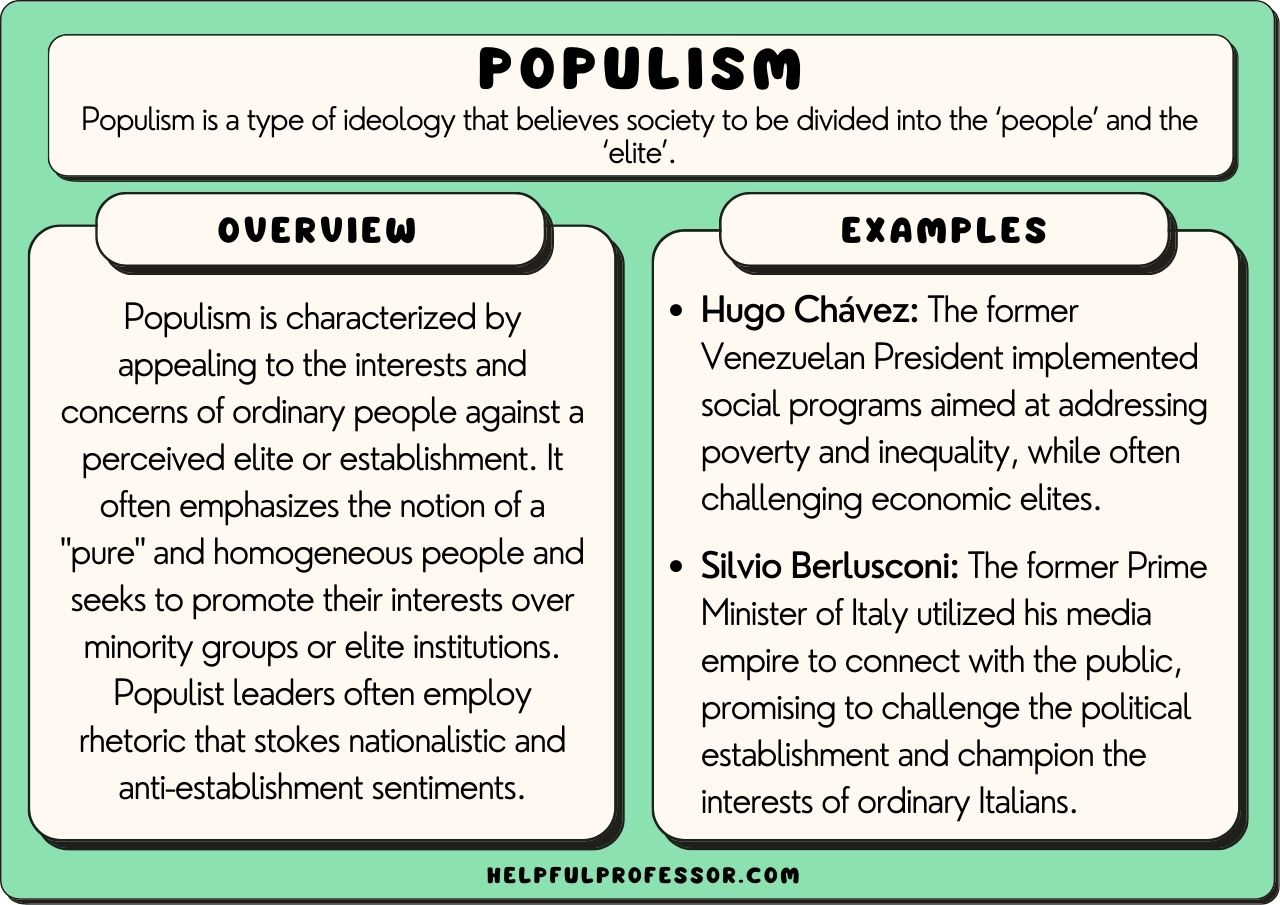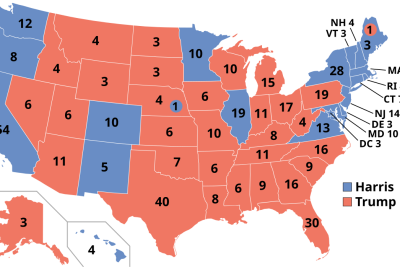
Populism: History, Facts, and Key Examples Explained

Populism is a dynamic political phenomenon that seeks to give voice to the common people and their concerns, often positioning these interests in direct opposition to a perceived corrupt elite or establishment. This movement generally thrives on the frustration and discontent felt by the masses, exploiting their emotions in order to gain traction in the political arena. While the essence of populism revolves around appealing to the ordinary citizen, its manifestations can vary widely, incorporating a mixture of both left and right ideologies, and frequently exhibiting characteristics that challenge traditional modes of political representation.
In recent years, the term "populism" has become increasingly relevant as many nations around the world experience a rise in populist sentiments. Around the globe, governments led by charismatic leaders tend to favor policies that foster extreme nationalism and identity politics, often at the expense of civil liberties and democratic norms. This trend raises pressing questions about the future of populism and its implications for societies that have traditionally valued democratic institutions, highlighting the need for a thorough examination of its history, key characteristics, and prominent examples.
- Definition of Populism
- Historical Context of Populism
- Key Characteristics of Populist Movements
- Populism on the Left vs. Right
- Case Studies of Notable Populist Leaders
- Populism and Authoritarianism
- The Impact of Populism on Political Parties
- Contemporary Examples of Populism Around the World
- The Negative Connotations of Populism
- Conclusion: Understanding the Future of Populism
Definition of Populism
At its core, populism can be defined as a political approach that strives to represent the interests and concerns of ordinary people, often viewed as being sidelined by the elite establishment. This definition encapsulates a broad spectrum of ideas, and while the goals of populist movements can often align with the aspirations of the general populace, the means by which these goals are pursued can vary significantly. Populism is not a singular ideology but a strategy that may be employed across the political spectrum, with different leaders framing their messages to resonate with specific demographics.
Populist sentiments frequently emerge in reaction to prevailing sociopolitical conditions, including economic inequality, governmental inefficiencies, or social injustices. These grievances are typically reframed into a narrative of "us vs. them," where the "us" refers to the disenfranchised common people and the "them" signifies the entrenched political or economic elites. This dualistic framing allows populist leaders to foster a sense of unity among their followers while simultaneously engendering division and resentment toward their opponents.
Historical Context of Populism
To understand the evolution of populism, it is important to consider its historical roots. The term itself originated in the late 19th century, specifically in the United States, with the formation of the People's Party in 1892. This party arose from the economic struggles of farmers and wanted to combat the dominance of railroads and industrialists by advocating for policies such as the direct election of senators and the implementation of a progressive income tax. The People's Party represented the first organized attempt to create a national political movement based on the concerns of the rural working class.
Throughout the 20th century, populist movements came to define various political landscapes across the globe. In Latin America, figures like Juan Perón in Argentina and Hugo Chávez in Venezuela harnessed the power of populism to mobilize large segments of the population, promising to address their concerns through social reforms and increased governmental involvement in the economy. Similar instances can be seen in Europe and Asia, where leaders have invoked populist rhetoric to challenge established political norms and galvanize support from disenfranchised segments of society.
Key Characteristics of Populist Movements
Populist movements share distinct characteristics that differentiate them from traditional political movements. These features include an emphasis on the dichotomy of "the people" vs. "the elite," a charismatic leader, and a simplified, often emotional narrative that addresses complex issues. One of the hallmarks of populism is its tendency to thrive on divisive rhetoric, presenting political issues in black-and-white terms that resonate with the emotions of the public.
- Charismatic Leadership: Populist leaders often possess a magnetic personality that enables them to connect with their followers on a personal level. They position themselves as champions of the people's cause, using their charisma to rally support.
- Anti-Establishment Sentiment: Populism is deeply rooted in a skepticism of political institutions and elites. Populist leaders often criticize established political parties, presenting themselves as alternatives to a corrupt status quo.
- Simplistic Solutions: Populist rhetoric frequently offers straightforward solutions to complex problems, appealing to the desire for quick and decisive action among followers.
- Nationalism: Many populist movements exhibit strong nationalist tendencies, seeking to prioritize the interests and values of the nation over those of outsiders or global entities.
Populism on the Left vs. Right
The broad spectrum of populism manifests differently on the left and right sides of the political spectrum. Leftist populism typically emphasizes social justice, advocating for the rights of marginalized groups while critiquing capitalism and economic inequality. This form of populism may include calls for wealth redistribution, universal healthcare, or environmental protections.
Conversely, right-wing populism often revolves around themes of nationalism and xenophobia, framing immigrants and foreign influences as threats to the cultural or economic well-being of the nation. Right-wing populists may also advocate for protectionist policies or the preservation of traditional social values in the face of rapid societal change.
This divergence in approach highlights the flexible nature of populism as a tool that can be wielded by various political groups to achieve different ends. While the underlying rhetoric may appear similar, the ideologies that frame these movements can lead to vastly different political outcomes.
Case Studies of Notable Populist Leaders
Several prominent leaders have emerged in recent history who exemplify the dynamics of populism in action. Each case showcases the distinctive characteristics and strategies utilized in their rise to power.
Juan Perón
In Argentina, Juan Perón is perhaps the archetypal populist leader whose tenure from the mid-1940s to the early 1950s transformed the nation’s political landscape. Perón's administration focused on social reforms that strengthened labor rights and expanded social welfare programs—initiatives that garnered widespread support among the working class. By passionately advocating for the "descamisados," or the shirtless ones, he cultivated a loyal base of followers who saw him as a champion of their cause.
Hugo Chávez
Drawing on the legacy of Perón, Hugo Chávez rose to power in Venezuela in the late 1990s and fashioned a brand of populism centered around anti-imperialist sentiment and economic nationalism. Chávez's government pursued policies that aimed to redistribute wealth through social programs, nationalization of various industries, and the creation of a political identity rooted in Bolivarian nationalism. His charismatic leadership and skill at manipulating public sentiment enabled him to maintain support even as his policies were increasingly criticized both domestically and internationally.
Donald Trump
In contemporary American politics, Donald Trump's candidacy and presidency marked a significant chapter in the evolution of right-wing populism. Trump’s rhetoric resonated with voters disillusioned by traditional political elites, portraying himself as an outsider fighting against a corrupt system. His messages often included nationalist themes, and he employed a style that was confrontational toward the media and perceived opponents. Trump's ability to simplify complex issues into easily digestible soundbites served as a powerful tool in mobilizing a base that felt largely ignored by the political establishment.
One of the concerning trends associated with populism in recent years is its propensity to drift toward authoritarianism. Leaders who come to power on a populist platform may progressively erode democratic norms, consolidating power in ways that undermine checks and balances, minority rights, and judicial independence. As populist leaders often style themselves as direct representatives of the people’s will, they may dismiss criticisms from traditional institutions, viewing such dissent as antagonistic to their mandate.
This slide into authoritarianism raises alarm bells about the sustainability of democratic practices in nations where populism takes hold. Political polarization can deepen, with populist leaders employing tactics that demonize opponents and evoke fears, thereby legitimatizing increasingly authoritarian measures.
The Impact of Populism on Political Parties
Populism significantly affects the political parties within the landscape it emerges. Traditional parties often face challenges in adapting to the populist wave, as they may struggle to connect with new voter demographics that prioritize different issues than the parties historically championed. This misalignment can lead to the fragmentation of established parties, giving rise to new populist entities that draw on public discontent.
Moreover, traditional political parties may attempt to co-opt populist rhetoric or issues in order to reclaim support, leading to shifts in policy platforms that cater to populist demands. This can manifest as a mixing of ideologies, where established parties borrow elements from the populist playbook to maintain relevance in an evolving electoral landscape.
Contemporary Examples of Populism Around the World
Today’s political landscape features a multitude of contemporary populist leaders and movements that shape national and international discourse. In Brazil, for instance, Jair Bolsonaro represents a brand of right-wing populism that emphasizes traditional values and strong nationalist rhetoric. In Italy, parties like the League and the Five Star Movement have risen to prominence through a platform that blends populist sentiment with opposition to immigration and the European Union.
Similarly, in India, Prime Minister Narendra Modi’s government displays characteristics of populism by appealing to Hindu nationalism and promoting policies that align with uplifting the perceived interests of the typical Indian citizen against an elite class. These diverse examples illustrate that while populism can take many forms, common threads of dissatisfaction with existing political institutions and a desire for representation resonate across national boundaries.
The Negative Connotations of Populism
While populism may resonate with a significant segment of the population, it also carries a series of negative connotations that merit discussion. Critics often point out that populist leaders can exploit fears and anxieties to further their political goals, engaging in demagoguery that plays to the lowest common denominator of political discourse. This can lead to an oversimplification of complex issues and a tendency to scapegoat minority groups or opposing political factions.
Moreover, the emotional appeal of populism can drown out reasoned debate, leading citizens to base their political views on sentiment rather than evidence. In the face of such manipulatively emotional rhetoric, democratic discourse suffers, resulting in polarized societies that struggle to engage in constructive dialogue.
Conclusion: Understanding the Future of Populism
As we move forward into an uncertain political future, understanding the complexities of populism becomes increasingly vital. The duality of its representation as a voice for the common people versus a potential slide into authoritarianism presents a paradox that requires careful navigation by democratic societies. Whether viewed as a necessary correction to elite dominance or a threat to democratic principles, populism is bound to remain a topic of significant debate.
In conclusion, engaging with the lessons from historical and contemporary examples can inform prospective strategies for addressing the underlying grievances that fuel populist movements. Politicians, scholars, and citizens alike must grapple with the implications of populism while striving to reinforce democratic institutions that serve the broader interest of society, rather than merely catering to the volatile sentiments of the moment.
Did you find this article helpful? Populism: History, Facts, and Key Examples Explained See more here Education.
Leave a Reply






Related posts